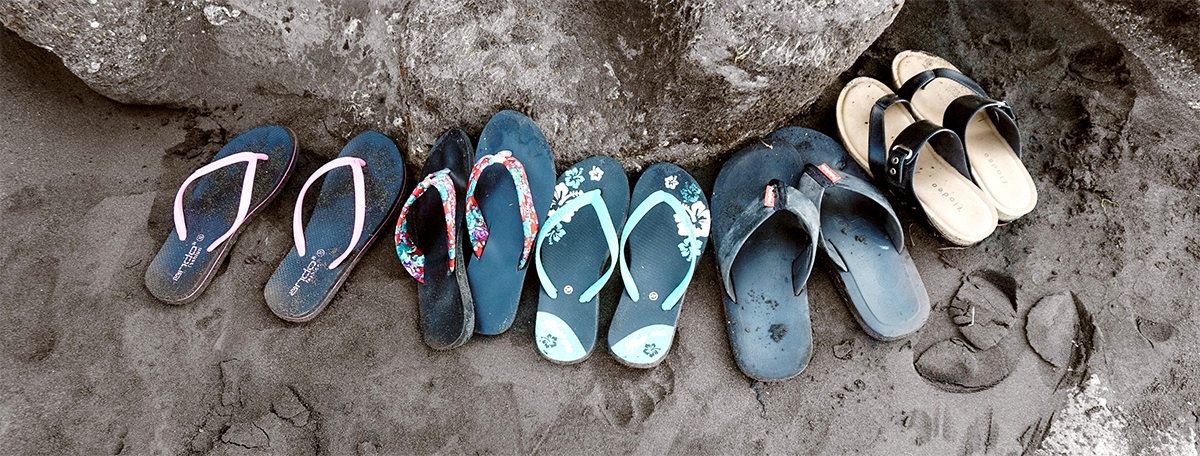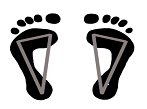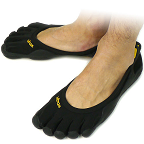
As soon as the first warm spring day arrived, the flip-flops came out of our closets or we go to a retail outlet and buy a new pair. There’s nothing like being able to move the feet without the restraint of socks and shoes. FREEDOM! Flip-flops arouse thoughts of summer fun and adventure. We keep them out in a handy location, slip them on quickly and spontaneously leave locking our front door and away we go! How many of us put much thought into the downside of what may seem like the ideal sandal?
How do you keep them on your feet?
Clenching your grip with the muscles in your feet while wearing them so they don’t fall off.
What happens to your feet if you wear them every day?
The muscles clenching the flip-flops can lead to repetitive motion injury because some of the ends of the bones are driven into the ground, creating higher-than-normal-pressure points, metatarsal (toe) injury, corns, calluses, and shortened toe muscles leading to HAMMER TOES (the knuckles of the toes crossing each other).

Illustration of tripod foot
Movement pattern changes: Asymmetry muscle imbalances alter postural alignment leading to compensations with our gait (how we walk), inflammation, knee pain, back pain, tight hips, loss of balance, coordination, and potential for falls and injury.
Tripod Foot consists of the center of the calcaneus (heel bone), the base of the 1st metatarsal (big toe) and the base of the 5th metatarsal (little toe).
Minimalist Shoes Next Best Thing to Walking Barefoot
 The most efficient biomechanical walking stride is heel-first into a forefoot push off when the foot remains on the ground. Whereas, when running, explains Ted McDonald — “Barefoot Ted” pioneer of the barefoot movement from Seattle, Washington — runners need to focus on a silent, smooth forefoot landing, quicken your cadence and run with stable, upright posture. McDonald explains that forefoot landings “…have the impact of landing start in the forefoot and quickly spread through the entire leg smoothly. Observe how a big cat or a dog by using flowing movement wastes little energy on the pound or sound.” As Pavel Tsatsouline Chief Instructor for Strong First states, “Expensive athletic running shoes or custom Orthotics can possibly set you back physically and financially is why shoes with minimal soles are required when training.”
The most efficient biomechanical walking stride is heel-first into a forefoot push off when the foot remains on the ground. Whereas, when running, explains Ted McDonald — “Barefoot Ted” pioneer of the barefoot movement from Seattle, Washington — runners need to focus on a silent, smooth forefoot landing, quicken your cadence and run with stable, upright posture. McDonald explains that forefoot landings “…have the impact of landing start in the forefoot and quickly spread through the entire leg smoothly. Observe how a big cat or a dog by using flowing movement wastes little energy on the pound or sound.” As Pavel Tsatsouline Chief Instructor for Strong First states, “Expensive athletic running shoes or custom Orthotics can possibly set you back physically and financially is why shoes with minimal soles are required when training.”
How to Choose the Right Size
Your heels and toes should not be hanging off the edge of the sole, inviting rocks and toys to give you a nasty cut or stubbed toe. Likewise, don’t just slip into an oversized pair with edges that can catch on uneven surfaces and cause you to trip. Take special care when driving while wearing flip flops. Three walkers were killed in 2011 when a motorist wearing her husband’s oversized flip flops caught one under the accelerator.
Replace Worn Out Flip Flops
Before you slip into them, look for cracks in the sole and uppers or signs that the post is coming loose. You don’t want a blow out to trip you up. If there is a deep foot indentation in the sole or you can see the outlines of your toes from last year, it’s time to replace them.
Sandal Recommendations
Luna Sandals strap to your foot and remain in place throughout the walking, running or hiking stride. They come in a variety of styles for every occasion. (I wear these comfortably all day). Available at gwells.co
 FitFlop Slingback Comber Sandals have a microwobbleboard in the sole that helps relieve pressure points and has a heel strap to aid in a good walking stride. I’ve worn them all day for walking while traveling, as well as at work. Many of their designs have a toe post, as well as a few designs without. Available on Amazon.com. Another option: Price Grabber.
FitFlop Slingback Comber Sandals have a microwobbleboard in the sole that helps relieve pressure points and has a heel strap to aid in a good walking stride. I’ve worn them all day for walking while traveling, as well as at work. Many of their designs have a toe post, as well as a few designs without. Available on Amazon.com. Another option: Price Grabber.
Foot Exercises
 Calf Stretch: Place the ball of your left foot on the apex of a half-foam roller or rolled-up folded towel. Drop the heel all the way to the ground, and straighten that knee. Step forward with your right foot. If you can’t bring your foot all the way forward, take a smaller step. Keep your weight stacked vertically over the heel of whichever foot is farther back. Hold for one minute, then switch legs; do this three times on each leg.
Calf Stretch: Place the ball of your left foot on the apex of a half-foam roller or rolled-up folded towel. Drop the heel all the way to the ground, and straighten that knee. Step forward with your right foot. If you can’t bring your foot all the way forward, take a smaller step. Keep your weight stacked vertically over the heel of whichever foot is farther back. Hold for one minute, then switch legs; do this three times on each leg.
Toe Tucks: Stand up straight on your right foot and reach your left foot back behind you, tucking the toes of your left foot under and placing them on the floor. Work up to holding this stretch for one minute. If your toes start to cramp, come out of the move, rest, and return when you can. Toes just too tight?
Try it seated: Building strong ankles and feet is paramount in switching to barefoot running injury free. This exercise routine will help build and maintain strength throughout your foot and ankle and lower your chance for injury. Do these exercises without shoes, with 3 to 4 sets of each exercise, increasing the repetitions or time as often as you can. Focus on form and range of motion.
Disclaimer: Feet exercises – It’s recommended you clear with your health care provider first before you start doing these feet exercises or any of the other exercises. Begin all exercises slowly build up progressively over time. Most individuals will need arch support in their shoes with a minimal sole to make sure they have contact
The Kettlebell Lady – Leanne Wylet, BA, ACE -NCCA – Specialties: Orthopedic Exercise, Functional Movement, Hard Style/High Intensity Kettlebell Fitness, Silver Sneakers FLEX & Tai Chi Instructor works with the aging population. On the MS Fitness Instructor Provider List & works with athletes from all walks of life & health conditions. A member of the Autoimmunity Support Group of Wenatchee, WA &, NCW Integrative Health Network & network with Wellness Place (support for those with or recovered from cancer) – Erin Cass & other non profit organization. Instruct Exercise Classes -Ageless Grace & Tai Ch, Power Point Presentation: Overcoming Fatigue Through Movement, private, semi private assessments with correctives, integrated into sessions, done in Studio, homes & businesses. Does Business Wellness & Injury Prevention to help reduce L & I claims, communicates with health care providers & writes detailed reports from functional movement assessments done to establish a safe baseline for an exercise program, attends local health fairs with booths, Speaker and Freelance Writer (technical & creative.) Visit her website, kettlebelllady.com
References
- Gate Guys, Exploring the link between human movement, biomechanics and gate, The http://thegaitguys.tumblr.com/post/33232417577/the-almighty-foot-tripod-you-have-heard-us-talk
- Wendy Bumgardner, How to Choose a Healthier Sandal, www.verywell.com/how-to-choose-healthier-flip-flops-3435240
- fitnessblender.com/blog/barefoot-running-injury-prevention-foot-and-ankle-strengthening-exercises
- Pavel Tsatsouline, Enter the Kettlebell, Dragon Door Publications, ©2006, www.dragondoor.com

